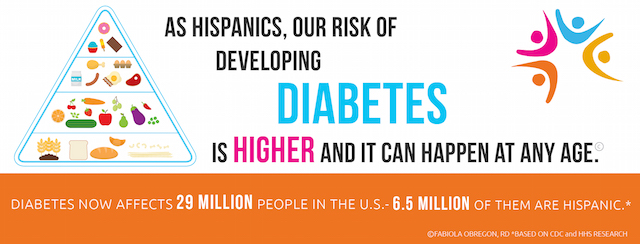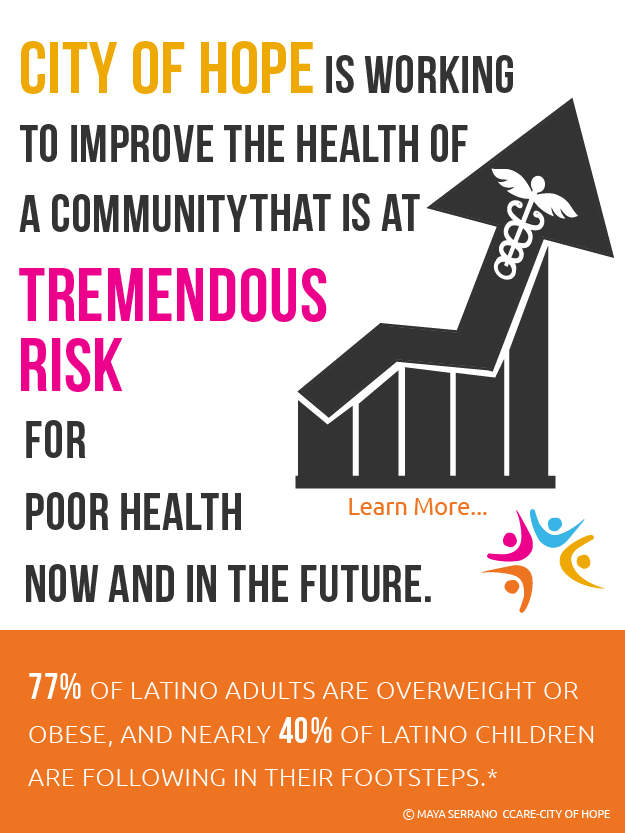
Diabetes & Healthy Nourishment Tips
06/30/2014 06:00PM | 10139 viewsDiabetes now affects over 29 million people in the United States. Its cost in 2012 alone was estimated at $245 billion. As Hispanics, we must be aware that our risk of developing diabetes is higher and it can happen at any age. Abnormally high levels of blood glucose (sugar) result from problems in how insulin is produced, how effectively it works at lowering blood glucose, or sometimes both.
The good news is that diabetes is manageable by medications, healthful eating, physical activity, and monitoring blood glucose levels. Taking those steps helps lower risk of developing complications such as kidney failure, heart disease, stroke, blindness, amputations, or premature death. Physicians, pharmacists, registered dietitians, and certified diabetes educators (CDE) are your best resources available for support. Here you will find a general starting point, the basics I like to cover as a registered dietitian. Let’s begin.

Diabetes & Diet: Covering the Basics
There are three food groups: Proteins, Fats, and Carbohydrates. With diabetes, watch your Carbs!
Carbs are also called “sugars” = starches, fruit, milk/yogurt, desserts & sweetened drinks
- Starches – Grains, crackers, bread, pasta, rice, potatoes, corn, peas, beans/legumes
- Fruit – Fresh/frozen/canned, juice, nectar, smoothies, marmalade
- Milk/Yogurt – Note this does not include all dairy
- RD Tip: Low-nutrition Carbs -- think cakes, pies, donuts, cookies, candy, regular soda -- may seem tasty and convenient, but ultimately they come at a great expense if you have diabetes: don’t sacrifice your health for cheap treats!
Carb Counting
- Sometimes called the Consistent Carbohydrate diet, the goal is to eat about the same amount of Carbs at each meal to help maintain better blood glucose control throughout the day
- 1 Carb = 15 grams (one carb serving is measured as 15 grams)
- Women: Goal limit is 2-4 Carbs each meal = 30-60 grams
- Men: Goal limit is 3-5 Carbs each meal = 45-75 grams
- Limit any snacks to 1-2 Carbs = 15-30 grams
- Try to eat 3 meals a day, around the same time each day, and avoid skipping meals
How do you know the Carb content and serving sizes of foods? Nutrition Facts food labels are your best resource, but for foods without a food label, here are some examples of 1 Carb servings:
1 small piece fresh
fruit (4 oz)
1/2 cup canned/frozen
fruit
1 slice of bread
1/2 English muffin
1/2 hamburger bun
1 (6 inch) tortilla
1/2 cup oatmeal
1/3 cup pasta or rice
4-6 crackers
1/2 cup black beans
1/2 cup starchy veggies
1/4 of a large baked
potato
2/3 cup plain fat-free
yogurt (unsweetened)
2 small cookies
2 inch square brownie or
cake (without frosting)
1/2 cup ice cream or
sherbet
1 Tbsp syrup, jam,
jelly, sugar or honey
2 Tbsp light syrup
Nutrition Facts Labels help keep track of serving sizes and carbohydrate content of each serving.
RD Tip: Only look at Total Carbohydrate grams; since Sugar grams are already included in this number, there is no need to double count!
The Plate Method
Use half of your plate for veggies, a quarter for grains (better if whole grains), and a quarter for lean meat/protein. To complete the meal, add a serving of your favorite fruit for dessert.
Did you know? The right plate sizes are 9 inches for adults and 7 inches for children.
Remember, diabetes is not about the protein and fat in foods…it’s all about the Carbs!
- However, choose lean protein sources and heart-healthy fats to help lower heart disease complications from diabetes
- What to choose more often? Baked, steamed, broiled, grilled
- What to choose less often? Fried, sautéed, au gratin
Looking for diabetes-friendly recipes and meal plans with nutritional information? At www.diabetes.org, by the American Diabetes Association, you can sign-up for MyFoodAdvisor: Recipes for Healthy Living. These monthly e-newsletters are free of charge! See below for an example.
Cilantro Lime Roasted Chicken
Yield: 6 servings
Nutritional Facts
Serving Size: ½ breast, 1 thigh or 1 drumstick + 1 wing
Calories 130
Total Fat 4.5 g
Saturated Fat 1.2 g
Cholesterol 55 mg
Sodium 55 mg
Potassium 165 mg
Total Carbohydrates 4 g
Dietary Fiber 0 gSugar 3 g *
Protein 18 g
* Carb Counting quick tip: only look at Total Carbohydrate grams; since Sugar grams are already included in this number, there is no need to double count!
Ingredients
Cooking spray
2 ½ pound whole chicken, cut into 8 pieces
2 tablespoons chopped cilantro
1 lime, zested and juiced
1 Tablespoon honey
2 cloves garlic, minced
½ teaspoon ground black pepper
½ teaspoon salt (optional)
Directions
- Preheat oven to 375 degrees F. Coat a baking dish with cooking spray.
- Remove the skin from the chicken and arrange in a single layer in the baking pan.
- In a small bowl, whisk together the cilantro, lime zest, lime juice, honey, garlic, ground black pepper and salt (optional). Pour the mixture evenly over the chicken and bake for 45-50 minutes or until the internal temperature of the largest piece of chicken is 165 degrees.
Side Suggestion: Frozen tri-color pepper mixture, steamed.
Remember diabetes is manageable, but not to be taken lightly. Feel empowered by taking charge of eating healthier, taking medications as needed, being physically active, and making the best use of resources and support from your health care providers.
Sources:
American Diabetes Association, MyFoodAdvisor
(www.diabetes.org/mfa-recipes/log-in/recipes-for-healthy-living.html?loc=ff-diabetesmealplans)
American Diabetes Association,
Carbohydrate Counting (http://www.diabetes.org/food-and-fitness/food/what-can-i-eat/understanding-carbohydrates/carbohydrate-counting.html#sthash.Wa3qcUSu.dpuf)
American Diabetes Association, Español
(www.diabetes.org/es)
Academy of Nutrition and Dietetics
(www.eatright.org)
National Diabetes Statistics Report
2014 (Centers for Disease Control and Prevention, U.S. Department of Health and
Human Services)












Post your Comment
Please login or sign up to comment
Comments